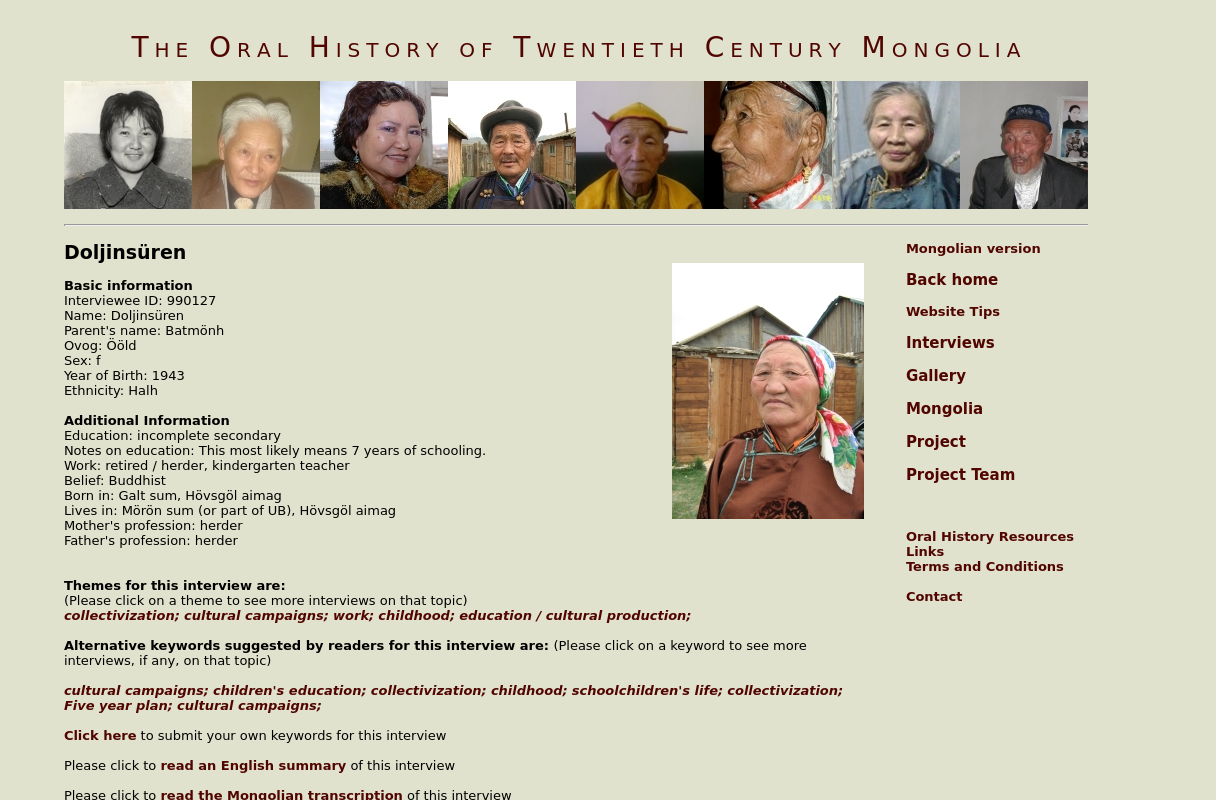Oral history interview No. 080820A with Doljinsüren: (b. 1943): translation
Metadata
collection
The Oral History of Twentieth Century Mongolia
identifier
2f7a4f9b-caa2-4e04-829f-b15bb157010b
creator
type
coverage
description
Born in 1943 in Galt sum of Hövsgöl aimag. From 15 years of age I have been working as a ‘check milker.’ A check milker is a person who checks how many litres of milk were milked on average from the farm cows. Later I had acquired some cows and milked them for two years and then in 1967 I moved to the aimag centre. I had worked for 27 years as a teacher at a kindergarten and at a nursery and retired. My dad had more than a thousand head of livestock. At the end of the 1950s he collectivized his livestock and joined the cooperative. As a member of a cooperative he retained 50 head of livestock and the rest he gave away to the cooperative. My mom drove the livestock together with my eldest brother and gave them to one ail. We had many livestock, and the children used to pasture the sheep, working in pairs. Therefore, when the livestock were driven to give away to the cooperative, we were very happy that we wouldn’t have to tend a lot of livestock. Before joining the cooperative the herders’ life was tough. To fulfil the five-year plan we gave away the livestock hair and wool, and the fat and the skin of the animals slaughtered for food were seized. There were awful times when we gave away even the ripped rugs and mattress. My dad put one or two sheepskin on piece a wood with the thought to make a deel for his children but they were confiscated, he used to say. In the countryside there was an announcement about a cooperative, and the brigade dargas began visiting the ‘ails’ agitating and insisting on them joining the cooperative. The majority of the people gladly accepted the collectivization. The rich people with many livestock joined the cooperatives in the end. Those with livestock had them seized, and those who didn’t have cattle gave away what they had, and in such a way they joined the cooperative. Some ‘ails’ hid their livestock tying them in the woods and drove them up into the mountains. Therefore special people went to the mountains to check. If there were grown children in the ‘ail’, they all became cooperative members and they used to become shepherds and milkmaids. My elder sister and I became milkmaids, and my younger sisters and brothers tended cows. The agitators [those carrying out propaganda] visited us and informed us about the events happening in the aimag and sums, and they also organized newspaper readings. Some countryside ‘ails’ that were doing ok had a radio, called ‘mother land’. Before joining the cooperative we had an open stove and we would be smoked by all the smoke it gave off. By joining the cooperative, we obtained ger blankets and stovepipes and began to be cultured. The people worked in the cooperative, received a salary and their living conditions improved. The work places increased with the existence of the cooperative centre and the brigade centre. Before the cooperatives people quarreled over the pasture lands but with the cooperative the land disputes stopped. The so called ‘cultural campaign’ checked up the ails’ hygiene and required that each family member had blanket, sheets and towels. The countryside people were made to draw a circle of 50 km [sic] and clean the environment. The people from the hospital and other responsible officers visited the ails and required the family to show the cup and towels and checked how many bed sheets and how many changes of clothes and how many face towels they had. If the requirements weren’t met, the people would be given assignments to do in a fixed time, and the people did them. If there was a dirty bed sheet, they would carry it away and bring it back half washed and the other half left dirty and they showed it at the meeting. They demanded that the countryside people put away their Buddhas and relics and display them openly. They taught how to hold the cups of tea from the edge when serving a guest and not put your finger into the cup. Such detailed things they used to teach. They installed a loudspeaker on a truck and they went through the streets telling this ‘ail’ was that bad and that ‘ail’ was that good. Therefore each ‘ail’ was for fulfilling the requirements. The ‘ails’ with good environmental hygiene and who fulfilled the requirements were given a ‘cultured ail’ certificate. That certificate was hung in the library. The cultural campaign was conducted in 1960-70. By conducting the cultural campaign the people gradually got accustomed to washing their clothes, taking baths and cleaning their environment.
publisher
Oral History of Twentieth Century Mongolia
source
rights
Copyright MIASU. Reproduced with permission. Brief excerpts from interviews and other material may be used in academic or popular work for non-commercial purposes provided proper attribution and credit is given to the Oral History of Twentieth Century Mongolia and the Mongolia and Inner Asia Studies Unit (MIASU). You must not: (a) republish this material (including republication on another website) without the express written permission of MIASU; (b) sell, rent or sub-license material from the website; (c) show any material from the website in public without attribution to The Oral History of Twentieth Century Mongolia; (d) reproduce, duplicate, copy or otherwise exploit material on the website for a commercial purpose without express written permission; (e) use the material in any way that is damaging to the project or any of the persons named in the interviews. See http://amantuuh.socanth.cam.ac.uk/terms.php for details.
subject
date
2008
language
files
| df-pdf | 190.8 KiB | 2017-05-29 12:11:12 | |
| df-screenshot | png | 47.9 MiB | 2017-05-29 12:11:12 |
| metadata-en | docx | 516.8 KiB | 2018-01-08 14:57:21 |
